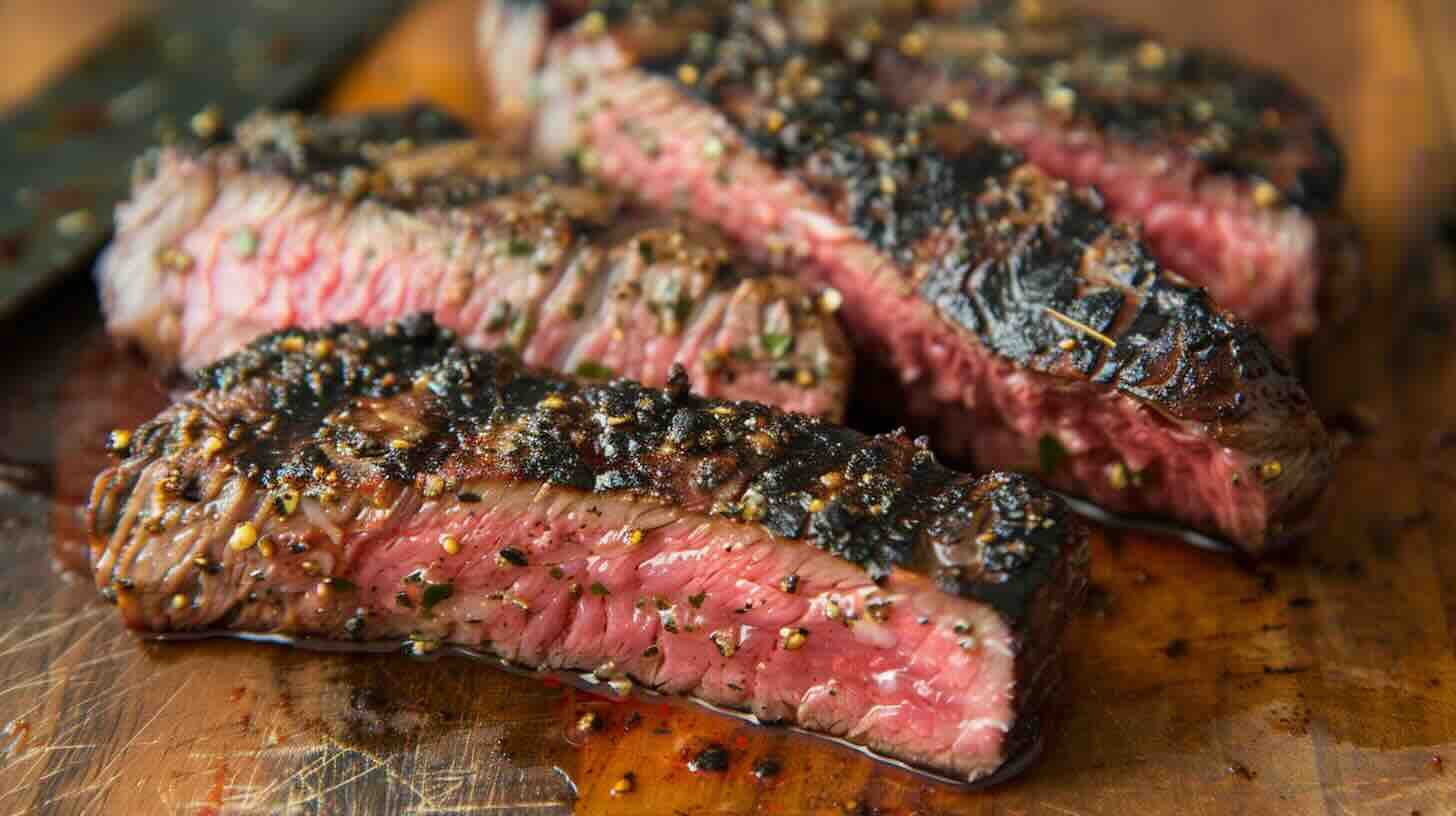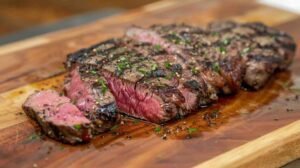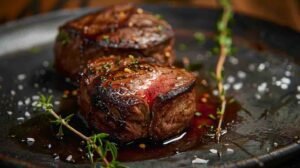The Reverse Sear Method
What is Reverse Searing?
Reverse searing is a cooking technique that involves initially cooking meat at a low temperature and then finishing it with a high-heat sear. This method is particularly popular for cooking steaks. The process starts by slowly roasting a steak in a 225–300°F oven until it reaches the desired internal temperature. The steak is then seared in a hot cast-iron skillet to create a dark, crisp crust. This technique was developed in the mid-2000s by J. Kenji Lopez-Alt, a James Beard award-winning author, as a way to perfect steak cooking indoors (Food Network).
Benefits of Reverse Searing
The reverse sear method offers several advantages for steak lovers:
- Even Cooking:
Reverse searing ensures even cooking throughout the steak, preventing the common issue of overcooked edges and undercooked centers. - Temperature Control:
This method provides more control over the level of doneness, allowing precise achievement of the desired internal temperature without guesswork (Grill Nation BBQ). - Perfect Crust:
By dehydrating the surface of the steak during the low-heat cooking phase, the reverse sear method creates a perfect crust when the steak is subsequently seared. This crust combines with the seasonings to produce a crunchy exterior (Y.O. Ranch Steakhouse). - Juicy and Tender:
The slow roasting process breaks down connective tissues, locking in natural juices, and resulting in a tender, flavorful steak that melts in your mouth (Sur La Table). - Flavorful Pan Drippings:
The pan drippings and juices formed during the cooking process can be used as a flavorful topping after the steak has been seared.
| Benefit | Description |
|---|---|
| Even Cooking | Prevents overcooked edges and undercooked centers |
| Temperature Control | Achieves precise internal temperature |
| Perfect Crust | Creates a crunchy, well-seasoned exterior |
| Juicy and Tender | Locks in natural juices for a tender texture |
| Flavorful Pan Drippings | Enhances flavor with delicious pan juices |
For more details on how to achieve these benefits, check out our reverse sear steak recipe. Whether you’re making a reverse sear filet mignon or a reverse sear tomahawk steak, the reverse sear method guarantees a delicious and perfectly cooked steak every time.
How to Reverse Sear Steak
Mastering the reverse sear method can elevate your steak-cooking skills and ensure perfectly cooked meat every time. Here’s a detailed guide on how to reverse sear steak, from seasoning and preparation to the cooking process and final sear.
Seasoning and Preparation
The first step in reverse searing a steak is proper seasoning and preparation. Start by selecting a thick-cut steak, such as a ribeye, filet mignon, or tomahawk steak. Season the steak liberally on all sides with salt and pepper to enhance the flavor.
Allow the steak to come to room temperature before cooking to ensure even cooking throughout. This can take about 30 minutes.
| Step | Action |
|---|---|
| 1 | Select a thick-cut steak (ribeye, filet mignon, etc.) |
| 2 | Season all sides with salt and pepper |
| 3 | Let the steak come to room temperature (about 30 minutes) |
For more unique seasoning ideas, check out our section on unique seasoning ideas.
Cooking Process
The reverse sear method involves cooking the steak slowly in the oven before finishing it with a high-heat sear. This technique provides more control over the steak’s level of doneness and ensures even cooking.
- Preheat the Oven: Preheat your oven to a low temperature, around 225°F (107°C).
- Prepare the Baking Sheet: Place a wire rack on a foil-lined baking sheet to prevent steaming, which can hinder the searing process.
- Bake the Steak: Place the seasoned steak on the wire rack and bake in the oven. Use a meat thermometer to monitor the internal temperature. Aim for 10-15°F below your desired final doneness.
| Desired Doneness | Target Temperature (°F) |
|---|---|
| Rare | 115-120 |
| Medium Rare | 125-130 |
| Medium | 135-140 |
| Medium Well | 145-150 |
| Well Done | 155-160 |
- Remove and Rest: Once the steak reaches the target temperature, remove it from the oven and let it rest for a few minutes to allow the juices to redistribute.
Searing the Steak
The final step in the reverse sear method is to sear the steak in a hot pan to create a flavorful crust. This step is crucial for achieving the signature dark, crisp exterior.
- Preheat a Cast-Iron Skillet: Heat a cast-iron skillet over high heat until it is smoking hot.
- Add Butter or Oil: Add a small amount of butter or oil to the skillet. The pan should be hot enough that the butter or oil sizzles upon contact.
- Sear the Steak: Place the steak in the skillet and sear each side for about 1-2 minutes until a dark, crisp crust forms. Ensure all sides get a proper sear.
- Serve Immediately: Slice and serve the steak immediately, without the need for additional resting (Food Network).
| Step | Action |
|---|---|
| 1 | Preheat cast-iron skillet until smoking hot |
| 2 | Add butter or oil |
| 3 | Sear each side for 1-2 minutes |
| 4 | Slice and serve immediately |
For more detailed instructions, check out our articles on reverse sear filet mignon, reverse sear tomahawk steak, and reverse sear ribeye steak.
By following these steps, you can achieve a perfectly cooked steak with a delicious crust, ensuring a restaurant-quality meal at home. For more recipes and tips, explore our reverse sear steak recipe.
Tips for Perfect Reverse Searing
Achieving the perfect reverse-seared steak involves several key steps. Here are some expert tips to ensure your steak turns out flawless every time.
Temperature Control
One of the main advantages of the reverse sear method is the ability to control the temperature precisely. By cooking the steak slowly at a low temperature, you ensure that it cooks evenly from edge to edge without overcooking the exterior (Grill Nation BBQ). This method provides a consistent doneness throughout the meat, which is crucial for a perfect steak.
| Steak Doneness | Internal Temperature (°F) |
|---|---|
| Rare | 120° – 125° |
| Medium Rare | 130° – 135° |
| Medium | 140° – 145° |
| Medium Well | 150° – 155° |
| Well Done | 160° |
Use an accurate meat thermometer to monitor the internal temperature of the steak. This will help you achieve the desired level of doneness without guesswork.
Resting the Steak
Resting the steak after the searing process is crucial for retaining its juices and enhancing its flavor. When the steak is allowed to rest, the moisture that has been driven to the outer layers during cooking is reabsorbed into the meat, ensuring a juicy and flavorful bite.
For optimal results, cover the steak loosely with aluminum foil and let it rest for at least 5-10 minutes after searing. This rest period allows the juices to redistribute, making every bite succulent and tender.
Flavor Enhancements
Enhancing the flavor of your reverse-seared steak can take your culinary skills to the next level. Here are some seasoning and flavoring ideas:
- Seasoning: Before cooking, generously season your steak with salt and pepper. For an extra layer of flavor, consider using a dry rub with spices like garlic powder, onion powder, and paprika.
- Butter Basting: During the searing process, add a pat of butter to the pan. As the butter melts, use a spoon to baste the steak with the melted butter for added richness.
- Herbs and Aromatics: Fresh herbs like rosemary, thyme, and garlic cloves can be added to the pan during searing. These aromatics infuse the steak with subtle, yet delicious flavors.
For more unique seasoning ideas and recipes, check out our section on reverse sear steak recipes.
Experiment with these enhancements to find your perfect flavor combination. Whether you prefer a simple seasoning or a more complex flavor profile, these tips will help you achieve a mouthwatering steak every time.
By mastering temperature control, allowing the steak to rest, and experimenting with flavor enhancements, you can take your reverse searing skills to the next level. For specific steak cuts and recipes, visit our guides on reverse sear filet mignon, reverse sear tomahawk steak, and reverse sear ribeye steak.
Exploring Different Reverse Sear Recipes
Reverse searing a steak opens up a world of culinary creativity. Here, we explore unique seasoning ideas, cooking variations, and resting techniques to help you master the reverse sear steak recipe.
Unique Seasoning Ideas
Seasoning is essential for adding flavor to your steak. While salt and pepper are classic choices, experimenting with unique seasoning blends can elevate your steak to the next level.
- Onion and Mushroom Powder: Adds a savory umami flavor.
- Balsamic Drizzle: Provides a tangy, sweet finish.
- DIY Spice Rub: Combine ground and toasted sesame seeds, peppercorns, poppy seeds, mustard seeds, salt, dark brown sugar, and dehydrated onion for a complex, robust flavor.
| Seasoning | Ingredients |
|---|---|
| Onion-Mushroom Blend | Onion powder, mushroom powder |
| Balsamic Glaze | Balsamic vinegar, brown sugar |
| DIY Spice Rub | Sesame seeds, peppercorns, poppy seeds, mustard seeds, salt, dark brown sugar, dehydrated onion |
Cooking Variations
The reverse sear method is versatile and can be adapted to various cooking environments. Here are some popular variations:
- Oven Method: Slowly roast the steak in a 225–300°F oven until it reaches the desired internal temperature, then sear on high heat (Sur La Table).
- Smoker Method: Smoke the steak on low temperature, then pan sear it on a preheated cast-iron skillet (Bearded Butchers).
- Grill Method: Use a gas grill on indirect heat for roasting, then sear directly over high heat.
For specific steak cuts, check out our guides on reverse sear filet mignon, reverse sear tomahawk steak, and reverse sear ribeye steak.
| Cooking Method | Description |
|---|---|
| Oven | Roast at 225–300°F, then high-heat sear |
| Smoker | Smoke on low temp, then cast-iron skillet sear |
| Grill | Indirect heat roast, then high-heat sear |
Resting Techniques
Resting your steak is a crucial step to ensure juiciness and flavor. Here are some techniques to consider:
- Tent with Foil: After searing, tent the steak loosely with foil and let it rest for 5-10 minutes. This allows the juices to redistribute.
- Cooling Rack: Place the steak on a cooling rack to rest, which helps keep the bottom from steaming and losing its crust.
- No Resting: Some prefer to skip resting and serve immediately to retain the crispy sear.
| Resting Technique | Benefit |
|---|---|
| Tent with Foil | Juices redistribute, retains warmth |
| Cooling Rack | Prevents bottom from steaming |
| No Resting | Retains crispy sear |
By experimenting with these unique seasoning ideas, cooking variations, and resting techniques, you can create a perfect reverse-seared steak every time. For more tips and tricks, check out our article on tips for straightening curly hair.



